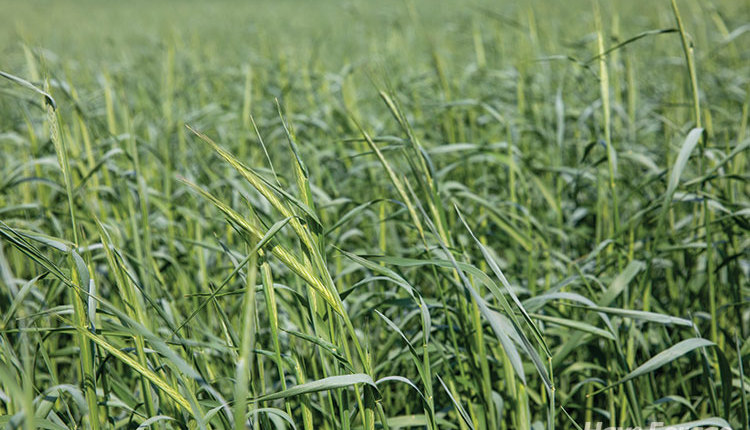The author is an associate professor and dairy management extension specialist with Virginia Tech University.

Different reasons exist for growing small grain crops on a dairy farm. Winter annual crops capture nitrogen from the manure applied to the soil, protect the soil from erosion, and provide forage for feeding cattle. In respect to forage production, it is sometimes believed that a double-crop rotation will yield more forage than a single crop rotation. However, a boost in total forage production due to double cropping does not always occur and should not be taken for granted.
What should farmers expect from their double-crop system? Likewise, how should farmers manage their double-crop system to maximize forage yield? Let’s evaluate some data that might help answer these questions.
A study done in Vermont and New Hampshire evaluated the production of forage under single- and double-cropping strategies in the context of an organic dairy production system. The study consisted of planting a full-season corn hybrid as a single crop at its optimum planting date (May 18 to May 25), a short-season corn planted after a winter crop (triticale or wheat) harvested at the boot stage of maturity (May 24 to June 10), and a short-season corn planted after a winter crop harvested at the soft-dough stage of maturity (June 28 to July 10).
Corn crop impacted
The full-season corn yielded 6 tons of dry matter (DM) per acre while the short-season corn harvested after the winter crops harvested at the boot and soft-dough stages yielded 5.3 and 4.3 tons of DM, respectively. The full-season corn contained 43.8% neutral detergent fiber (NDF) and 38.6% nonfiber carbohydrates (NFC), whereas the short season corn harvested after the boot-stage small grain contained 44.7% NDF and 37.8% NFC. The short-season corn harvested after the soft-dough small grain contained 53% NDF and 29.4% NFC.
These partial results highlight that planting corn after a winter crop harvested at the soft-dough stage substantially affects the yield and quality of the corn crop, whereas planting corn after a winter crop harvested at the boot stage slightly reduces yield and minimally affects quality.
The winter crop harvested at the boot stage yielded 3 tons of DM per acre, whereas the winter crop harvested at the soft-dough stage yielded 5.2 tons of DM per acre. Therefore, the total forage production was 6 tons of DM per acre for the full-season corn, 8.3 tons of DM per acre for the short-season corn plus the boot-stage winter crop, and 9.5 tons of DM per acre for the short-season corn plus the soft-dough winter crop.
Results from this study show that the double-crop system yielded more forage than the single-crop system. That being said, it seems like these plots were not evaluated as an integrated rotation, and it is worth mentioning that some of the corn plots in this study were harvested after a killing frost. Considering an annual, integrated rotation, it is unanswered what would have been the impact of the late harvest on a following small grain crop, which would have been planted later than recommended.
Different location and results
Another study performed in Minnesota evaluated the effect of a rye and corn double-crop system on total forage production. Corn planted under a single-crop system yielded 7.5 to 9.5 tons of DM per acre, which is 25% to 58% more yield than that reported in the previously discussed trials. In Minnesota, the double-crop system yielded 6.2 to 8.7 tons of DM per acre, nevermore than the single-crop system within the same year or over a period of three years.
Similar to the previous study, delayed planting negatively affected corn yield. A big difference, however, is that the winter crop in this study produced 1.3% to 19.1% of the total forage produced, which is substantially less than in the first study (36.3% to 54.5%). In agreement with the latter study, another New York trial reported that triticale produced 15.9%, at the most, of the total forage production in a double-crop system with sorghum.
Managing a double-crop system to maximize forage production on a dairy farm is more complex than one might think. First and foremost, the geographic location and climate are major determinants to the success of a double-crop system as they will determine the optimum planting and harvesting dates for the winter and summer crops.
The contribution of the winter crop on the total forage yield should be considered when evaluating a double-crop system. The production advantages might be minimal when looking at the whole system, and the effort of growing a winter crop might not be worthwhile. That being said, if a double-crop system is used, the planting and harvest dates of both winter and summer crops should be optimized so that the crops are synergistic. Also recognize that there are agronomic and environmental benefits for growing a small grain between corn crops, and these might outweigh small losses in yield.
This article appeared in the August/September 2022 issue of Hay & Forage Grower on page 16.
Not a subscriber? Click to get the print magazine.

